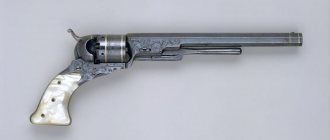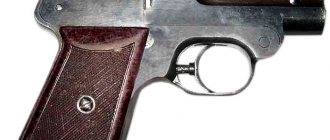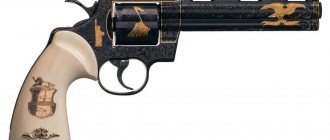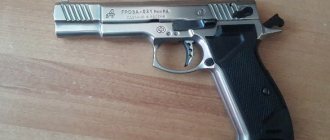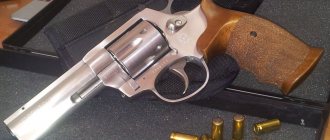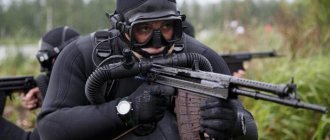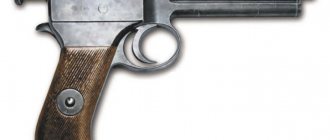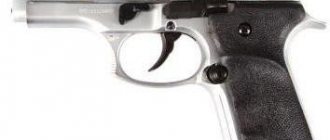Revolvers - past, present, future
Home | Weapons | Additional Articles | Revolvers - past, present, future
In the 20th century, revolvers, as a type of personal firearm, reached their greatest prosperity and popularity in the 50-70s in the United States of America. Revolvers have always been in great demand in this country, dating back to the days of the “Wild West” and capsule Colts. The rapid development and widespread distribution of this type of weapon in the United States began with the early capsule Colt 1851 Navy and Colt 1860 Army, as well as Smith & Wesson No. 1 chambered for a unitary cartridge. Later came the famous Colt 1873 Peacemaker .45 caliber and Smith & Wesson No. 3 .44 caliber. The use of unitary cartridges provided a great advantage in loading speed and ease of storing ammunition compared to capsule systems.
Beginning with the Adams Model 1851 in England and the Starr 1858 Army in the United States, revolvers began to be made with a double-action trigger mechanism, which allowed the weapon to be fired by self-cocking by simply pulling the trigger without first cocking the hammer. The combination of using a unitary cartridge and a trigger mechanism with self-cocking made the revolver a convenient, practical weapon with very high combat qualities for its time. Instead of sequential extraction of spent cartridges, like the Colt 1873, drums that tilt to the side began to be used, which again significantly increased the rate of fire.
Compared to systems loaded with a release case, used in Smith & Wesson No. 3 revolvers and English Webleys, the design with a folding cylinder and a monolithic frame provided both a longer service life and higher accuracy of shooting of revolvers with a large round of shots. These innovations greatly improved the combat qualities of revolvers and continue to be used today with minimal changes. By the beginning of the 20th century, the following models became the most famous and popular models: Colt New Service 45th, 44th and 38th calibers, which was later adopted by the US Army under the name Model 1909; Smith & Wesson New Century revolver in 45 and 44 calibers, with reinforced Triple Lock cylinder locking design; Smith & Wesson Military & Police 1905 38-caliber revolver, which became the most popular military revolver in the United States in the first half of the 20th century.
Military & Police became especially popular because it had small dimensions and weight, low recoil force and a very reasonable cost. In total, over 6 million M&P revolvers were produced. During World War I and World War II, the US and British armies used the Colt Model 1917 and Smith & Wesson Model 1917 revolvers, which fired .45 ACP pistol cartridges with a wafer case. It was these revolvers from the beginning of the century that became the basis for the design of those revolvers that are currently offered by weapons manufacturers. Changes in modern models compared to their predecessors relate mainly to the materials used and production technology.
Colt 1909 revolver chambered for .45 Long Colt
Smith & Wesson Military & Police 1905 .38 gauge with blue finish and walnut grips
Since the end of World War II, modern-style revolvers have been in service with the US police and army. It should be noted that revolvers have always been popular in America, and did not lose their positions in the civilian and police arms markets even after the advent of well-proven self-loading pistols, such as the Colt M1911 or FN Browning High Power. Powerful full-size revolvers were very popular among road patrols, where police officers are still armed with them. These were classic revolvers produced by the largest weapons manufacturers - the famous American companies Smith & Wesson, Colt and Ruger. Full-size models used the powerful .357 Magnum cartridge, which has a high stopping and penetrating effect of the bullet.
Compact ones, used as a rule by FBI agents or plainclothes police officers, as well as by citizens for self-defense, used the .38 Special cartridge, which was significantly inferior in its combat qualities. It’s paradoxical, but true - despite the availability of revolvers chambered for 9 mm .357 Magnum, 11.5 mm .45 LC and .45 ACP cartridges that have proven highly effective in real combat and in police practice, revolvers chambered for weak 9-mm cartridges have been sold in the millions .38 Special. The Smith & Wesson Military & Police was especially in great demand, becoming perhaps the most popular revolver in its class. Its advantages, as well as other 38-caliber revolvers, were the low cost of weapons and ammunition, as well as soft recoil without strong bounce when fired, which are the main reasons for its success.
Colt Detective Special .38 caliber, 1950 release. The drum holds 6 rounds.
Smith & Wesson Model 36 Chief's Special sub-cartridge .38 Special with 5-round cylinder capacity
The most famous compact revolvers of the 20th century, which achieved enormous popularity in the USA, were the Smith-Wesson models S&W Model 36 Chief's Special (in production since 1950), S&W Model 40 (produced since 1952), S&W Model 49 Bodyguard (produced with 1957) and S&W Model 60 (produced from 1965), as well as the Colt Detective Special (produced from 1927 to 1995). American manufacturers had a large line of full-size .357 Magnum revolvers with a variety of frame sizes, barrel lengths, materials and finishes that were consistently purchased by various law enforcement agencies and, of course, sold well on the civilian gun market.
The most popular of the full-size models were the S&W Model 27 (produced from 1935 to 1994), S&W Model 19 (in production since 1957), S&W Model 66 (produced from 1970 to 2005), S&W Model 686 with a stainless steel frame (introduced in 1980 and still in production) and the S&W Model 586 with an alloy steel frame and blued finish (in production from 1982 to 1998). The Colt company began producing the famous Colt Python revolver in 1955. Less known, but still popular, were the Colt Trooper MKIII, Colt MKV (in production from 1953 to 1985), and the Colt King Kobra (in production from 1986 to 1998). The period from the end of World War II to the second half of the 1980s. is the "golden age" of American revolvers.
Just look at the famous Colt Python, which uses .357 Magnum cartridges, which became a star among weapons in Hollywood and Elvis Presley’s favorite revolver. This weapon is distinguished not only by its exquisite design, but also by its excellent workmanship and surface finish, excellent shooting accuracy and reliability. Python is still produced by Colt. The most charismatic of the large-caliber revolvers was the Smith & Wesson Model 29 revolver, introduced by the manufacturer in 1955 and discontinued by the end of the 1990s, using the most powerful .44 Magnum cartridge at that time. This weapon in the United States is most associated with the police officer nicknamed “Dirty Harry” from the famous 1971 film starring Clint Eastwood, in addition to the Model 29, of course. It is especially worth highlighting the highest quality of workmanship of revolvers produced before the mid-1980s, which today can only be obtained in more expensive weapons.
The quality workmanship on this blued Colt Python is evident at first glance.
The S&W Model 29 was the epitome of power thanks to the .44 Magnum cartridge and... Hollywood
The high popularity and wide distribution of revolvers is explained not only by their ease of use, reliability, high shooting accuracy, efficiency when using, for example, .357 Magnum cartridges or even less powerful .38 Special cartridges, equipped with expansive bullets with high stopping power, but also, of course, by established habits. It is noteworthy that the excellent Georg Luger pistol, which later became known as the Parabellum, with advanced combat and performance qualities for its time, which still remains the standard for ease of holding, shooting accuracy and weapon aesthetics, was not adopted by the US Army mainly because for the established stereotypes of the American military, who preferred revolvers rather than new weapons that were not yet familiar to them.
Of course, at first, a good reason for the Americans to abandon the Luger pistol was the weak 7.65×22 cartridge compared to the .45 Long Colt revolver, but soon the designer introduced a model chambered for the 9×19 cartridge, and then a version chambered for the new American pistol cartridge. 45 ACP. However, in this case, prejudices prevailed. Although it should be noted here that the Luger pistol was much more expensive than any American revolver, the production of which had long been established and the army had vast experience in handling these weapons. In Europe, on the contrary, self-loading pistols have become widespread. These were mainly John Browning designs, produced by the Belgian FN and copied in huge quantities by Spanish manufacturers, Georg Luger pistols, manufactured by the German DWM, and the equally famous Mauser pistol-carbines.
Colt M1911A1 semi-automatic pistol
Colt Government manufactured in 1928
But soon even the American military realized the advantages of automatic weapons, adopting, which later became one of the most popular self-loaders, a pistol designed by Browning - the famous Colt M1911 45 caliber. Moreover, at the beginning of its career this pistol was not as popular among ordinary citizens as it was in the 70-90s. and currently. The M1911 fully demonstrated its advantages in high fire efficiency on the battlefields of the First World War. For example, the feat of US Army Corporal Alvin York, who killed six German soldiers armed with Mauser rifles attacking him with his M1911, is widely known. Its modernized version, designated M1911A1, also performed well during World War II.
However, from the moment the self-loading Colt was adopted into service until the second half of the 20th century, in the civilian arms market it was popular mainly among those who had served in the army and navy, while revolvers were popular among ordinary citizens and police officers. The version of the M1911 for the civilian weapons market, called the Colt Government Model, which differed from army weapons only in the higher quality of the coating and stamps, was not liked by everyone because of its size and weight. It is difficult to carry such a massive pistol with you constantly and secretly. Compact revolvers, on the contrary, are very convenient, lightweight and much easier to handle than the Government Model. It was only in the 1950s, thanks to articles about the advantages of the M1911 by one of the most famous pistol pilots, journalist and founder of modern practical shooting, Jeff Cooper, that the M1911A1 gradually began to be purchased by some police departments and gain popularity among citizens.
Smith & Wesson Model 19
Ruger GP100
Thus, from the first quarter of the 20th century until the 80s, two branches of personal short-barreled weapons dominated in the United States - compact and full-size revolvers, as well as self-loading pistols from Colt. The fighting qualities of full-size revolvers, especially the efficiency of firing .357 Magnum cartridges, suited everyone, but time does not stand still and self-loading 9 mm pistols with a large magazine capacity soon began to arrive in large quantities on the largest weapons market in the world. They quickly began to gain popularity in the country of revolvers and soon began to displace the weapons familiar to Americans.
In addition, these pistols were equipped with a double-action trigger mechanism, which made it possible to safely carry a loaded weapon that was in full combat readiness, without the need to turn off the safety lever. But nevertheless, in terms of ease of use and reliability of operation, such pistols were inferior to revolvers, since in the event of a misfire, the revolver can always fire the next shot simply by pressing the trigger, while the owner of a self-loading pistol can reliably eliminate the delay in firing it is necessary to remove the misfired cartridge by sending the next one from the magazine into the chamber of the barrel. Examples of 9 mm pistols with a large magazine capacity, double-action trigger mechanism and reliable safety systems are the American Smith & Wesson Model 59 (in production from 1970 to 1988), the German Sig Sauer P226 (manufactured since 1981) and the Italian Beretta series 92 pistols (manufactured since 1976).
The S&W Model 59 9mm pistol with a 14-round magazine is considered the first of the "wonder nines"
The Glock 17 remains one of the most popular and best-selling semi-automatic pistols in the world.
Such pistols became known in the USA as “wonder nines”, that is, “amazing nines”. A significant fact is the rearmament of the US Army in 1985 from the usual Colt M1911A1 to the Beretta M9 - the popular Italian Beretta M 92FS pistol produced in America. However, in the early 1980s. revolvers were still the favorite weapon of ordinary citizens and police officers. The stopping power of the 9mm Parabellum cartridge bullets, including hollow-point ones, was not comparable to that of the .357 Magnum revolver bullets. Out of habit, revolvers were still trusted more than, for example, the same self-loading Smith-Wesson pistols. Among small-sized personal weapons for concealed carry, compact revolvers chambered for the .38 Special cartridge also remained unrivaled.
Since 1980, following the 9-mm repeating pistols, the basic design of which dates back to the first quarter of the 20th century, the most serious competitor for all previously produced short-barreled weapons went into production - the Austrian self-loading pistol Glock 17, which has only automatic safeties and a trigger a striker-type mechanism, with preliminary, partial cocking of the firing pin when the bolt-casing moves back and additional cocking when the trigger is pressed. This meant that this weapon could be instantly fired and carried constantly without the risk of an accidental shot, with maximum simplicity and ease of use. The design of the Glock is extremely simple and is based on the proven and improved Browning locking system; the metal parts have a very durable Tenifer coating that is extremely resistant to corrosion and wear.
Thanks to all these qualities, the weapon has phenomenal reliability in difficult operating conditions and a huge service life. In addition, the Glock frame is made of polymer, due to which it is very light in comparison with revolvers and self-loading pistols made of steel or with light alloy frames. In terms of firepower, the Glock 17 pistol is not at all comparable to revolvers, since its double-row magazine holds 17 rounds, versus a maximum of 7 or 8 for revolver drums. The Colt M1911 pistol, equipped with a single-action trigger mechanism with the ability to be safely carried in full combat readiness only with the hammer cocked and the safety on, as well as its copies, could no longer dominate in the United States among self-loading pistols.
Having taken leading positions in the weapons market, multi-shot modern 9-mm pistols began to displace revolvers, which were unable to compete with them in terms of the combination of combat and operational qualities. Despite habits and stereotypes, under the influence of new technologies and the advantages of self-loading pistols, revolvers are practically a thing of the past. In most police departments they were replaced with pistols, and citizens began to purchase Glocks, Sig-Sauers, Berettas, ChZs, Heckler-Kochs, Rugers, Smith-Wessons, Walters and other “self-loaders” for self-defense and sporting and recreational shooting. From the mid-1980s to the present, the main type of short-barreled personal weapon has been a self-loading pistol. However, the revolver did not lose its undeniable advantages, thanks to which these weapons continue to be used willingly.
Eight-shot Taurus 627 Tracker
Full size Smith & Wesson Model 327 M&P R8 revolver chambered in .357 Magnum with an aluminum-scandium frame and 8-round cylinder capacity
In the late 1990s, new materials began to be used in the production of revolvers, such as alloys based on aluminum and titanium, lightweight and durable aluminum-scandium alloys. Drums are made either of stainless steel with an additional anti-corrosion, usually matte black coating, or of titanium. As a result, revolvers got rid of one of their main drawbacks - heavy weight, while maintaining the necessary safety margin, a fairly long service life and excellent corrosion protection. Now it has become convenient and easy to carry not only compact, but also medium-sized revolvers with you at all times. Full-size models are still very rarely used for wearing due to their size.
Smith-Wesson and the Brazilian Torus were especially successful in using new technologies and materials. Their lineup includes a variety of lightweight and durable modern revolvers chambered for a variety of cartridges. Although the recoil force when firing from such a revolver, if it uses the powerful .357 Magnum cartridge, has increased significantly, the new weapon has become very popular and has a stable demand, both in the civilian market and among police officers. In addition, for training, revolvers under .357 Magnum most often use the much less powerful .38 Special, when fired with much less recoil force. The drum capacity has also increased. Many modern revolvers have a seven- and eight-round drum, which is more than enough for self-defense. Of course, self-loading pistols are in service today in the US army and police, as well as in other countries of the world. In United States police, revolvers are a rare exception and are only used in low crime areas where the officer does not need high firepower or by highway patrols. Revolvers are most popular among ordinary citizens.
The American Smith & Wesson Model 686 revolver is a true classic among modern full-size six-shooters.
The Smith & Wesson Model 625 JM revolver uses .45 ACP cartridges
Full-size models chambered for the .357 Magnum cartridge, with a barrel length of 102 mm / 4 inches and drums with a capacity of 6, 7 or 8 rounds, are rarely used as the main short-barreled weapons, since, surpassing modern pistols in reliability, bullet stopping power of the cartridge used, accuracy firing in single-action mode and ease of handling, they are significantly inferior to repeating pistols in rate of fire, firepower (the drum capacity is more than half that of a double-stack magazine of a medium-sized pistol) and have significantly larger dimensions, especially in width.
Such weapons are stored at home or in a car for self-defense. They are often used in various types of sports shooting and even for hunting, as well as for the purpose of self-defense from predators during hiking trips. Mid-sizes such as the Smith & Wesson 625, with a 102mm/4" or 127mm/5" barrel, chambered in .45 ACP, are most popular among sport revolver shooters due to the fast reloading of the plate clips and low recoil. and tossing when firing, and as a result, a higher rate of fire and accuracy of high-speed fire. In addition to these advantages, this weapon is highly effective in combat shooting, thanks to the high stopping power of the .45 ACP cartridge bullet. Therefore, such weapons are universal in areas of application and can also be purchased for self-defense.
Smith & Wesson Model M&P 360
Featuring an ultra-light Scandium frame, the Smith & Wesson Model M&P 340 is very comfortable and lightweight to carry. This specimen is equipped with rubber grip cheeks with a built-in laser designator.
Compact five-shot, with 51 mm / 2 inch barrels, chambered for the .357 Magnum cartridge, ideal for concealed carry for self-defense or as a backup weapon due to the combination of small dimensions and weight with the high stopping power of the bullet of the cartridge used. This class of revolvers is the most popular at present and will most likely be the most popular in the future. In addition to the qualities of the revolvers themselves, the arms market currently offers many very useful accessories, such as fiber optic front sights and rubber grip cheeks with a built-in laser designator. Practice has shown the advantages of front sights with fiber-optic, light-collecting inserts in the form of green or red rods, which reduce the time of pointing the weapon at the target, since the axis of the rod is a guide for the flow of light, as a result of which the shooter’s attention is instantly concentrated on the front sight, and then it is very easily quickly aligns with the rear sight slot.
One of the best representatives of modern compact revolvers is the American Smith & Wesson M&P 340 with an aluminum-scandium frame, a hidden hammer and only a self-cocking trigger mechanism, which has a very smooth ride and low trigger pull, light weight and compactness. This five-shot revolver chambered for the powerful .357 Magnum cartridge is very convenient for constant concealed carry, not burdensome and easy to handle for its owner. Of course, such a lightweight revolver, weighing only 414 g, has strong recoil, but it is not intended for sport shooting, since it is primarily a self-defense weapon. According to the enormous volume of information on the use of personal short-barreled weapons and statistics maintained by the US police, shooting to kill using compact concealed weapons is carried out at ultra-short distances - from point-blank shooting to 4-6 meters. In this case, the first shots are decisive, and the capacity of the revolver drum, designed for 5 rounds, is quite sufficient for such use of weapons.
It is necessary to clarify that for police weapons carried openly as the main one, on the contrary, a large amount of ammunition is required, as evidenced by the practice of using service weapons by the police. For close combat, in any case, the stopping effect of a bullet is of great importance, since it is necessary to neutralize the enemy as quickly as possible. The .357 Magnum revolver cartridge copes well with this task, as evidenced by decades of its practical use by police officers and citizens in self-defense. The reliability of a weapon is also of great importance, and a revolver has always been orders of magnitude superior, and will continue to be superior in this quality to any self-loading pistol. All of the above-mentioned features of revolvers and the ammunition used in them, combined with new technologies and materials, paved the way for this type of personal weapon in the 19th century and ensured its, although not very high, but nevertheless very stable popularity, which is confirmed by the constant appearance of new models on the arms market.
Additional articles
- Self-cocking pistols
- Merwin-Hulbert revolvers
- Weapons retroconservatism
- Shooting canes and umbrellas with a blade
- Revolvers - past, present, future
- Revolvers Velodog
- Walther Model 9 pocket pistol
- Colt Detective Special - Noir Style Revolver
- Gletcher CLT 1911. Affordable Colt
- Gasser M1870/74 Montenegrin
- British gun "Brown Bess" - an imperial classic
- Modular grenade launcher XM-25
- RPK 74M
- RPK 16
- RPL-20 and KORD-5.45.
Cartridges for modern weapons
Today, revolvers are loaded with unitary cartridges with a metal sleeve. The first such element was designed by N. Dreyse back in 1827, long before the appearance of the revolver. At that time, such a cartridge was used in long-barreled weapons.
Over time, the idea was picked up by the creators of revolvers. Such a charge consisted of a metal sleeve, a primer and a bullet.
Currently, models of modern revolvers are weapons with a double action trigger mechanism. The drum of such revolvers tilts to the left side, and when a special extractor is pressed, all the cartridges are pulled out of it. Many revolvers are chambered in powerful .357 Magnum and .44 Magnum calibers. Cartridges for such weapons consist of a cartridge case with a special rim (rim) that holds the cartridge in the drum. Cartridges without this element are also possible. In this case, holders are used to hold them - plates in the shape of two crescents.
Rapid development
In the early 19th century, cap locks were created, which brought the evolution of small arms to a new level.
In 1807, the English master Forsyth patented the use of shock mixtures for charges. The pistol was improved thanks to the invention of a rifled design, a rotating drum and a charger. Together with capsule combustion, all these details brought firearms to a new level of development.
The main goal facing the designers was to increase the rate of fire. Without this important quality, no other characteristics made much sense. Of course, other parameters (accuracy, killing ability and compact size) also had not yet been brought to perfection, but they more or less suited the specialists.
The rate of fire was completely absent. The lengthy process of loading the pistol, coupled with the proximity of the enemy, made the weapon disposable. After ensuring mass production of pistols, craftsmen began to work on increasing the rate of fire of weapons of this type.
Modern weapons of Europe
The first official patent for drum pistols was received in Britain. And today, European manufacturers surprise consumers with their original approaches to creating firearms.
This also applies to the French modern Manurhin MR 73 revolvers of .357 Magnum caliber. The first weapon was created at the Manurin factory and was similar to the Walter pistol. At the same time, the firearm somewhat repeated the system of the Smith & Wesson revolver. The difference was the double-action trigger mechanism, which had a locking trigger pull. The Manurin drum holds 6 rounds.
Belgian brothers Henri-Leon and Emile Nagant created revolvers that became popular all over the world. At first they repaired the Dutch Hemburg guns, but soon decided to produce their own firearms. And although the first Nagan appeared back in 1878, it remains the leader among revolvers today.
40s and 50s
In 1941, the Tula plant stopped producing revolvers, passing the baton to IZHMASH. After the war, revolvers were removed from service with the Soviet army. Some of them were transferred to the Ministry of Internal Affairs, where they were used until the 50s.
In famous films about that time (for example, “The Meeting Place Cannot Be Changed”), criminal investigation officers and criminals use revolvers. However, the criminal world still preferred revolvers for their reliability and the fact that after a shot the cartridge case remains in the drum, and not at the crime scene.
Later revolvers became traumatic and then signal weapons.
History of creation
Firearms are believed to have been invented in China in the 12th century. In Europe, the creation of artillery dates back to the 14th century. These were the first samples in which the shells operated due to the force of burning gunpowder. Thus began a new era in military affairs - firearms. A little later, hand-held samples of a new type of weapon appeared: arquebuses, arquebuses, culverins. During the 14th and 15th centuries, firearms remained virtually unchanged, apart from minor improvements in their design.
Noticeable changes occurred in the 16th century after the wheel lock was created, replacing the less perfect one - the matchlock. The author of the revolutionary invention was Leonardo da Vinci. Since that time, pistols (the first of them appeared in the 15th century) began to be equipped with a wheel lock.
In addition, at the end of the 16th century, the length of their barrel was increased and the caliber was reduced. Over the next two hundred years, wheel locks were gradually replaced by flint locks, which were cheaper and easier to load. The external characteristics of the weapon have also become more rational and elegant. Dueling-type pistols with special qualities appeared.
Further development
In 1877, the Belgian designer Emil Nagan patented his weapon model. Later they began to call it the “Nagant system revolver.” The weapon turned out to be very successful; it was used in many countries. Including in Russia.
In 1892, Nagan created a new model that combined all the best characteristics of previous mechanisms. It was a weapon with smokeless powder and a bullet inside the casing. This Nagant system revolver was used by the Belgian police until the 40s of the 20th century.
Nagant weapons were manufactured and used in many countries. It was valued for:
- excellent fighting qualities;
- reliability in use;
- safety during storage;
- quick readiness for battle.
In Poland, these weapons were called “radoms” after the name of the city in which the manufacturing plant is located. In the USA, such designs were called the Smith and Wesson revolver after the company that produced them.
Flaws
The Nagan “healed” in Russia on its own, becoming an iconic weapon. It was increasingly used as a combat revolver. It was used in many military actions of the time.
The plant in Tula produced self-cocking revolvers. However, the use of weapons also revealed its shortcomings. The main one is a long reload after firing all the cartridges.
In 1910, the Belgian model was improved: the revolver drum tilted to the right, and the reloading process was accelerated.
Another disadvantage was the tightness of the trigger and the need to use force to cock the hammer and rotate the drum. Handling weapons required training from the shooter and a strong hand. Over time the build has deteriorated. For this reason, during the Civil War, commanders used imperial pre-revolutionary copies, erasing the marks from them.
Victory in Russia
After the Crimean War of 1853-1856 in Russia, the question arose about the need to replace pistols with more advanced designs. In 1859, the Armory Commission began to review and analyze various models of revolvers produced abroad.
The French revolver “Lefoshe” was recognized as the best. Experts noted the rate of fire and reliability of this type of weapon.
At the end of the 19th century, a competition was announced in Russia to rearm the army. Models were needed that would replace the outdated Smith and Wesson revolver, since the army needed more powerful weapons.
The Nagan brothers took part in this competition. As a result, their improved samples won it. The commission adopted two models of weapons: non-self-cocking and self-cocking. After this, 20 thousand copies were produced in Belgium, and later these revolvers began to be produced in Russia.
General concept
Pistols and revolvers are similar in parameters, but differ in structure. A pistol is any type of firearm that is held in one hand. In this sense, answering the question: “What is a revolver?”, one should understand that it will also be considered a pistol, but with its own structural specifics. This means that its charges are in a drum that rotates. That is why such a weapon was called a revolver: from the English verb revolve - “to rotate.”
A similar drum and other innovations made it possible to distinguish it from the pistols that existed at that time. Interestingly, pistols these days are technically more advanced than revolvers. Previously, the designs were single-shot, they were called flint or capsule, but today all models of such weapons are automatic. Now it becomes clearer what a revolver is.
